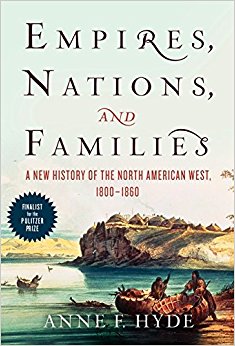Empires, Nations, and Native Women
Cynthia Prescott, University of North Dakota
 I finally carved out time to read Anne F. Hyde’s masterful Empires, Nations and Families: A New History of the North American West, 1800-1860. Once I picked up Hyde’s 650-page volume, I had trouble putting it down.[1] Winner of the prestigious 2012 Bancroft Prize and a finalist for the Pulitzer Prize in History, Hyde’s 2011 book is part of a University of Nebraska Press series that reassesses the field of United States Western history. Hyde brings together the latest scholarship in ethnohistory, colonialism and settler colonialism into a wide-ranging yet highly engaging narrative of the trans-Mississippi West. By tracing the networks built by prominent interethnic families engaged in the fur trade, Hyde makes sense out of the seeming disorder of global economies and geopolitics. She guides her reader through the complex and often messy world of hunters, merchants, and politicians from St. Louis to San Francisco, from Fort Vancouver to Santa Fe, and from the Great Lakes to the Arkansas Valley.
I finally carved out time to read Anne F. Hyde’s masterful Empires, Nations and Families: A New History of the North American West, 1800-1860. Once I picked up Hyde’s 650-page volume, I had trouble putting it down.[1] Winner of the prestigious 2012 Bancroft Prize and a finalist for the Pulitzer Prize in History, Hyde’s 2011 book is part of a University of Nebraska Press series that reassesses the field of United States Western history. Hyde brings together the latest scholarship in ethnohistory, colonialism and settler colonialism into a wide-ranging yet highly engaging narrative of the trans-Mississippi West. By tracing the networks built by prominent interethnic families engaged in the fur trade, Hyde makes sense out of the seeming disorder of global economies and geopolitics. She guides her reader through the complex and often messy world of hunters, merchants, and politicians from St. Louis to San Francisco, from Fort Vancouver to Santa Fe, and from the Great Lakes to the Arkansas Valley.
By focusing on a few prominent families, such as the Chouteaus in Missouri, McLoughlins in Oregon, Vallejos in California, and others – such as Stephen Austin and Kit Carson who seemed to be everywhere at once, Anne Hyde brings to life the complexities and contingencies of fur trade and frontier life. Hyde’s narrative provides a culturally complex picture because she focuses on the interethnic family networks that these “great men” built in places that became known as the American West. She painstakingly reconstructs these Euro-American men’s marriages and informal unions with French, Anglo-American, and Native women from many different Indigenous nations, and their resulting children and broader kinship networks. Perhaps even more clearly than the rich scholarship of the fur trade, Hyde demonstrates the centrality of these interethnic family relationships to the history and culture of the region. Native women provided needed labor and cultural knowledge, and offered entrée into Native cultures. White traders survived and even thrived largely because of their relationships with Native women. And, as Hyde makes equally clear, many of them struggled to maintain or abandoned those familial ties in the 1850s and 1860s as American racial understandings hardened around fixed categories. In memory, a Catholic Canadian of Scottish and French descent could become the white American “Father of Oregon,” but his Cree and French Canadian wife could not become the “Mother of Oregon” (and John McLoughlin’s Ojibwe first wife gets forgotten altogether).
Yet as Hyde admits in her introduction, “[m]uch of what I describe is really an updated version of ‘great man’ history” (Ecco 2012 ed., p. 21). Rich collections of correspondence among Euro-American businessmen reveal their thoughts and actions and, in some cases, their ethnically mixed sons. While their Native and mixed race wives and daughters contributed greatly to the overall success of their undertakings, these women’s experiences and perspectives remain frustratingly unclear if not completely invisible. Hyde does an admirable job of attempting to recreate these women’s experiences, but too much of what we would like to know about them is simply not in the written records. The lives and thoughts of these fur trade women – like those of Native men and women throughout the region who did not marry prominent white traders – receive little attention in the available written sources.
Uncovering the history of rural women is extremely challenging due to their dual invisibility as both rural people and as women. Studying them is challenging because rural people and women often failed to leave much written record. Moreover, these groups were long disregarded by scholars, archivists, and even their own descendants, so what records they did create have been lost to us. All of these challenges are exaggerated in regard to women of color, who were even less likely to be literate and their experiences less likely to have been recorded and preserved. And while many Indigenous cultures valued women’s contributions and granted women authority in ways that white society did not in the early nineteenth century, those traditions tended to be oral rather than written, and had very different conceptions of time than did the Euro-American culture out of which the historical profession developed.
Important work has been done uncovering the contributions of Native and mixed-heritage women in the fur trade, particularly in the Great Lakes region and eastern Canada. Those scholars’ innovative methods could be applied to other regions and cultural contexts. Much more research is needed to uncover nineteenth-century Native women’s lives. At the same time, much more work should also be done to preserve contemporary Indigenous women’s voices throughout the American West and around the world.
Anne Hyde gives us a sweeping yet intimate narrative of the worlds that Euro-American traders and Native peoples built in the early-nineteenth-century West. It should also serve as a call to arms to delve deeper into researching, documenting and preserving Native women’s voices both past and present.
[1] Hyde summarized her detailed study in this C-SPAN video: https://www.c-span.org/video/?321943-1/empires-nations-families.
